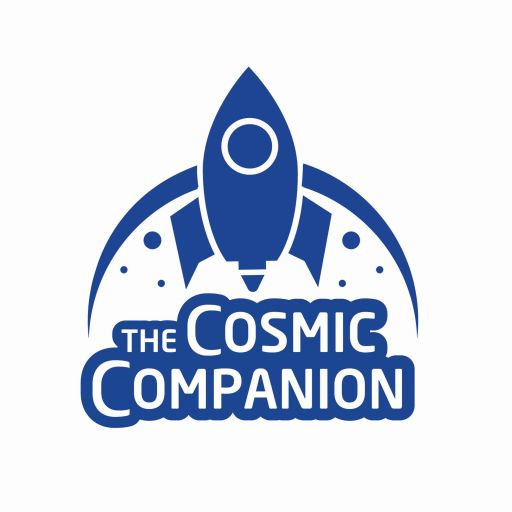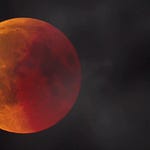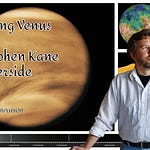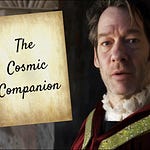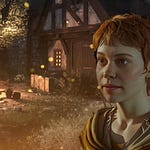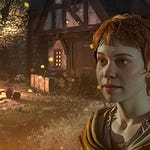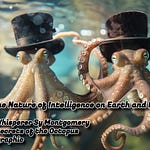Hello, everyone!
We are back with Season 8 of The Cosmic Companion!
I am SO excited about this upcoming season, and I hope you are as well!
Our first show of the year features our new short film, Moonbeans, followed by a look at Moonstruck: Tales of Earth’s Lunar Love Affair, talking with Rebecca Boyle, author of Our Moon.
VIP Subscribers get to see outtakes from the episode below!
Enjoy the show!
James
MOONBEANS:
Astronaut 2 (A2): Brashford! What are you doing?! Put your helmet back on!
Brashford: (nonchalantly) Relax, it’s fine.
A2: How is it fine? We’re on the Moon!
Brashford: (gestures around) The Moon just needed a little atmosphere. So I dimmed the lights, started playing smooth jazz, added some themed decor, couple of orchids. It was a breeze. Eventually.
A2: (looks around, noticing the changes, then at A1) You… you terraformed the Moon?
Brashford: Just this little bit. Now, are you going to join me for lunch or what? I just built a small cafe on the other side of that crater wall.
A2: So that’s where you were when you were supposed to be helping me with the chemistry experiments?
Brashford: It takes chemistry to make a good cup of coffee…
A2: I… guess I could go for a sandwich… Hey! Do we have any kimchi?
(They sit together at the open-air cafe on the Moon, A2 still looking around in disbelief, as smooth jazz plays softly in the background.)
You turned the Moon into a chill spot. NASA’s gonna love our expense report!”
Brashford: “Houston, we have a latte!”
UNICORN: The Cosmic Companion season 8 premiere, featuring James G. Maynard. This week: Moonstruck: Tales of Earth’s Lunar Love Affair. Talking with Rebecca Boyle, author of Our Moon.
More than four-and-a-half billion years in the past, Earth 1.0 — the first version of our home world, was on a collision course with Theia, a celestial body as big as Mars. It would be a date with destiny.
[Hi! I’m Destiny!]
This cosmic dance resulted in a spectacular crash, ripping both worlds apart. The aftermath? A molten mess which quickly cooled down, giving birth to two celestial bodies we now call home — Earth and our loyal sidekick, the Moon.
But this story wasn’t done yet. That would be too early in the episode…
Gravity from our new planetary dance partner reached down into the ocean depths, pulling up nutrients and enriching the waters. It was like the Moon was setting the table for the grand banquet of life.
But wait — there’s more! The Moon’s pull also kept Earth’s wobble in check, making our planet’s dance in space more graceful. This moderated climatic changes, providing a smoother ride for life around the globe.
Since that ancient age, tidal forces have also lifted oceans and land alike twice a day.
Many cycles of life are now dependent on the Moon.
Sand hoppers, adorable little crustaceans found on sandy beaches around the United Kingdom, have unique ways of living, thanks to our planetary companion.
Imagine being a tiny critter living at the water’s edge. Stray too far up the land, and you’re either a dried-up beach bum or the world’s tiniest shrimp cocktail. Head too close to the water, and you’re washed out to sea.
But fear not, our sand hopper friends have a solution — a pair of natural compasses. One in their brain, sunbathing by day, and another in their antennae, moon-gazing at night.
Birds like Barau’s petrels also have a lunar love affair. They always show up for their breeding dates under the light of a full moon. Maybe it’s just more romantic that way?
Sea turtles, the laid-back parents of the animal kingdom, time their egg-laying so the hatchlings pop out when the tides are just right. It’s basically their one act of parental care, so let’s cut them some slack.
And let’s not forget the dung beetles, rolling their precious poop balls by the light of the moon, all to avoid losing their treasure or becoming someone’s dinner.
Next up, we chat with Rebecca Boyle, author of Our Moon. Stay tuned!
Have you ever noticed how the Moon loves to play peekaboo in the sky? It’s no wonder we’ve been using its phases to keep track of time since… forever. Heck, we even named a day of the week after it — Moonday!
The Moon has been a muse for artists, writers, and musicians throughout history. Take the Nebra Sky Disk, for instance. Here it is! [HOLD UP DISK] This ancient LP-sized bronze disk from 3,600 years ago, decked out with gold celestial bodies and an image of our moon, is the world’s oldest star chart.
Fast forward to the first century BCE, and we’ve got the Antikythera mechanism — the world’s first analog computer. This ancient gadget could predict the positions of the Moon and Sun in the sky, eclipses, and even the schedule for Olympic games. The Antikythera was an awesome ancient app 20 centuries before smartphones!
In 1609, Galileo took his brand-new telescope for a spin, sketching the Moon’s mountains and craters. Though he (and everyone else for two or three hundred years) thought they were produced by volcanoes, we now know these craters are the result of asteroid impacts. This revelation of a rough, torn lunar surface shook up the idea of perfect celestial bodies.
Flash forward to 1969, and the world watched in awe as Apollo 11 landed on the Moon, uniting humanity together for one short moment, watching fellow humans traipse across the next great wonderland.
The next pioneers to leave their footprints on the lunar surface might be part of NASA’s Artemis program or they could be from China’s CNSA. Regardless of their origin, this is a monumental step as we, as a species, venture beyond our planetary cradle, taking our first steps towards the stars.
Our Moon might be considered “The Eighth Continent” of Earth. The geocorona, Earth’s outermost layer of atmosphere, rich in hydrogen, encompasses the Moon.
With vast stores of water ice in its southern craters, the Moon will almost certainly be our launching pad on the human journey toward a future free from scarcity and poverty.
So, here’s to our Moon, the celestial body that keeps on giving! Next week on The Cosmic Companion, we’re chatting about Jaws, Claws, Life, and Death with Jennifer Szymanski, author of Deadliest Animals on the Planet.
Don’t forget to join us on 10 February. And yes, we’re on Substack — just head to TheCosmicCompanion.com.
Clear skies!
James
VIP EXTRAS BELOW!
Listen to this episode with a 7-day free trial
Subscribe to AI Creator House to listen to this post and get 7 days of free access to the full post archives.



